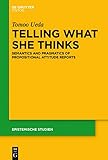Telling What She Thinks : Semantics and pragmatics of propositional attitude reports / Tomoo Ueda.
Material type: TextSeries: Epistemische Studien / Epistemic Studies : Philosophy of Science, Cognition and Mind ; 33Publisher: Berlin ; Boston : De Gruyter, [2015]Copyright date: ©2015Description: 1 online resource (170 p.)Content type:
TextSeries: Epistemische Studien / Epistemic Studies : Philosophy of Science, Cognition and Mind ; 33Publisher: Berlin ; Boston : De Gruyter, [2015]Copyright date: ©2015Description: 1 online resource (170 p.)Content type: - 9783110438802
- 9783110429701
- 9783110429596
- 160 23
- P99.4.P72 U33 2015eb
- online - DeGruyter
- Issued also in print.
| Item type | Current library | Call number | URL | Status | Notes | Barcode | |
|---|---|---|---|---|---|---|---|
 eBook
eBook
|
Biblioteca "Angelicum" Pont. Univ. S.Tommaso d'Aquino Nuvola online | online - DeGruyter (Browse shelf(Opens below)) | Online access | Not for loan (Accesso limitato) | Accesso per gli utenti autorizzati / Access for authorized users | (dgr)9783110429596 |
Frontmatter -- Contents -- List of Figures -- List of Tables -- Acknowledgments -- List of abbreviations -- Part I: Introduction -- 1. The central problems -- Part II: State of research -- 2. Structured propositionalism and its shared assumptions -- 3. Indirectness of speech and role of deixis -- 4. Metaphysical status of propositional attitudes -- Part III: Communicational approach -- 5. Communicative framework and discursive opacity -- 6. Opacity as a feature of the frame -- 7. Adverbial account of the frame -- Part IV: The VarCA analysis -- 8. The VarCA Analysis -- 9. Consequences of the opaque VarCA -- Part V: Concluding remarks -- 10. Conclusion -- List of sentences -- Bibliography -- Source of linguistic data -- Index
restricted access online access with authorization star
http://purl.org/coar/access_right/c_16ec
Frege’s puzzle concerning belief reports has been in the middle of the discussion on semantics and pragmatics of attitude reports: The intuition behind the opacity does not seem to be consistent with the thesis of semantic innocence according to which the semantic value of proper names is nothing but their referent. Main tasks of this book include providing truth-conditional content of belief reports. Especially, the focus is on semantic values of proper names. The key aim is to extend Crimmins’s basic idea of semantic pretense and the introduction of pleonastic entities proposed by Schiffer. They enable us to capture Frege’s puzzle in the analysis without giving up semantic innocence. To reach this conclusion, two issues are established. First, based on linguistic evidence, the frame of belief reports functions adverbially rather than relationally. Second, the belief ascriptions, on which each belief report is made, must be analyzed in terms of the measurement-theoretic analogy.
Issued also in print.
Mode of access: Internet via World Wide Web.
In English.
Description based on online resource; title from PDF title page (publisher's Web site, viewed 28. Feb 2023)


